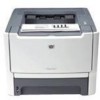HP P2015 HP LaserJet P2015 - Software Technical Reference - Page 210
Mopier mode and collation, Postscript Passthrough (PS 3 Emulation Unidriver only), Mopier Mode
 |
UPC - 882780491984
View all HP P2015 manuals
Add to My Manuals
Save this manual to your list of manuals |
Page 210 highlights
The HP LaserJet P2015 supports the transmit-once mopying feature when the Mopier Mode: setting on the Device Settings tab is Enabled. When you use the HP PCL 6 Unidriver, HP PCL 5e Unidriver, or PS 3 Emulation Unidriver, mopying is performed in one of two ways: either through the software or through the device hardware. When the mopier is enabled, mopying takes place through the device hardware by default. One copy of a multiplepage print job is transmitted once through the network to the device, together with a printer job language (PJL) command directing the device to make the specified number of copies. When you disable the mopier, you are not necessarily disabling mopying, which the driver can still perform through the software rather than the device hardware (the mopying path that is disabled when you change the Mopy Mode setting to Disabled). However, a multiple-copy print job that is sent when the mopier is disabled loses the advantage of transmitting the print job once, because the job is sent through the network for each copy. Mopier mode and collation Mopying and collating print jobs are independent but closely related functions. Mopying, the ability to send original print jobs to the device, is performed by the print driver. Collating can be controlled by either the print driver or the document software program. The mopying mode is selected by default in the driver, and can be disabled by changing the Mopier Mode setting on the Device Settings tab to Disabled. Control collation through the print driver by selecting or clearing the Collated check box on the Advanced tab. You can clear the check box, which is available only when the Copy Count option is set to more than 1 copy, to allow the software program to control collation. To receive uncollated multiple copies of a print job, clear the Collated check box and make sure that the software program collation feature is not selected. The following table shows the relation between mopier mode settings and collation settings in the software program and the driver. The first three columns show the settings; the last column, "Expected result", shows how a 3-page print job would appear. Table 4-5 Driver mopier mode and collation settings Mopier mode Application collation Driver collation Expected result Disabled Not selected Not selected 3 copies uncollated Disabled Not selected Selected 3 copies uncollated Disabled Selected Not selected 3 copies collated Disabled Selected Selected 3 copies collated Enabled Not selected Not selected 3 copies uncollated Enabled Not selected Selected 3 copies uncollated Enabled Selected Not selected 3 copies collated Enabled Selected Selected 3 copies collated Postscript Passthrough (PS 3 Emulation Unidriver only) Postscript Passthrough is enabled by default, and must be enabled for most print jobs. Postscript passthrough provides additional capabilities for some software programs when printing to a postscript driver. Options such as Watermarks, n-up and Booklet Printing might not print correctly from some 192 Chapter 4 HP PCL 6, PCL 5, and PS emulation unidrivers for MS Windows ENWW















